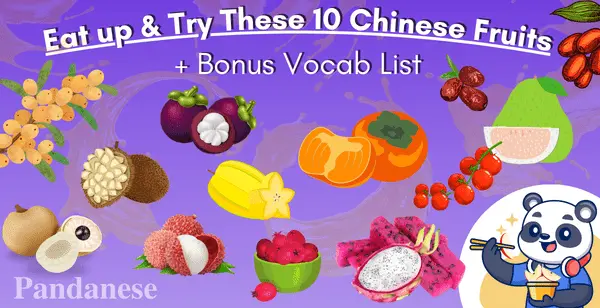
Eat up & Try These 10 Chinese Fruits + Bonus Vocab List
With its vast landscapes and diverse climates, China offers many tasty exotic fruits you should try if you plan to visit the country. You will find fruit everywhere, from bustling Chinese markets to traditional rural orchards.
In this article, we'll take you on a journey through some of the must-try fruits in China. We will also see some intriguing stories, proverbs, and superstitions associated with fruit.
You can find a vocabulary list of various fruits in Chinese at the end of this article.
10 Must-try Chinese fruits
1. Lychee (荔枝—lìzhī)

Lychee
Known as the "King of Fruits" in China, lychee is famous for its sweet and fragrant flavor. On the outside, it has a bright red shell. On the inside, it is white and juicy. In China, lychees are often enjoyed fresh at the end of a meal or used to prepare puddings.
2. Dragon Fruit (火龙果 – huǒlóngguǒ)

Dragon fruit
This tropical fruit looks and tastes delicious. Dragon fruits can be found with vibrant pink or yellow skin, and their peculiar appearance will surely strike your eye: on the inside, its flesh is white, hot pink, or red, speckled with black seeds. Dragon fruit has a delicate, sweet flavor and is rich in antioxidants; it has many health benefits.
3. Pomelo (柚子 – yòuzi)

Pomelo
The pomelo is the largest citrus fruit with its large size and thick rind. This delicious fruit has a sweet yet slightly tangy taste, similar to oranges, making it a favorite during the Mid-Autumn Festival.
4. Longan (龙眼 – lóngyǎn)

Longan
Translated as "Dragon Eye," Longan's translucent flesh resembles an eyeball. Its delicate sweetness and unique texture make it a popular choice for snacks and desserts in China.
5. Persimmon (柿子 – shìzi)

Persimmon
With a rich orange hue and a sweet, honey-like flavor, persimmons are often associated with good fortune and abundance during the harvest season.
6. Mangosteen (山竹 – shānzhú)

Mangosteen
Similar to a passion fruit, open these fruits up and you’ll get a tasty treat inside.
Referred to as the "Queen of Fruits," mangosteen has a tough purple rind and juicy, tangy-sweet white segments.
7. Kumquat (金桔 – jīnjú)

Kumquat
Kumquats are small, oval-shaped citrus fruits eaten raw and whole, including the peel. They have a sweet and tart flavor and are commonly used in cooking, baking, and for making preserves. They are rich in Vitamin C.
8. Jujube (枣子 – zǎozi)

Jujube
Also known as Chinese dates, jujubes are eaten fresh or dried. This fruit symbolizes prosperity in Chinese culture, so receiving them as gifts is common, especially during Chinese New Year.
9. Star Fruit (杨桃 – yángtáo):

Starfruit
This fruit takes its name from the fact that, when cut, the slices are shaped like a star. This fruit offers a sweet and slightly tangy taste.
Thanks to its peculiar shape, Star fruit is often used to garnish dishes and beverages:
Starfruits being used as garnish and decorations in food | Dianxi Xiaoge10. Hawthorn (山楂 – shānzhā):

Hawthorn
They are used in sweet and savory dishes, as hawthorn berries are known for their sour taste. They are often made into sugar coated fruit as Chinese street food or into jams
Bonus #1: Cherry tomatoes (小西红柿 – xiǎo xīhóngshì)

Chinese fruit salad | Sohu
They are not Chinese, but in China, you will probably eat them in a way that is different from what you’re used to. In China, cherry tomatoes are considered fruit, and just like any other fruit, they are eaten as a snack and can be found in fruit salads.
Bonus #2: Durian (榴莲 – liúlián)—a fruit I wish I didn't try!
This fruit is a hit or miss for people!
Durian's strong smell and flavor usually don't appeal to a broad audience. You will recognize it once you smell it. Still, it's important also to learn the Chinese word for it and the character, or you'll end up accidentally ordering a Durian pizza – like I did.

Durian pizza | Twitter
Interesting facts about fruit in Chinese culture
Many Chinese fruits are out of our plates and into Chinese culture. Let's see where else you can find them.
Superstition—pears are not good gifts
Superstitions play an important role in Chinese culture. Thus, some fruits are considered lucky and symbolize prosperity or fertility.
According to a particular superstition, giving pears (梨 – lí) as gifts is considered unlucky and is therefore often avoided in Chinese culture due to the homophonic similarity between "pear" (梨 – lí) and "separation" (离 – lí ) in Mandarin.
The origin of Longan fruit
Chinese fruits are often associated with legends explaining their origin. For example, the story below is one of the legends explaining the origins of Longan, a popular Chinese fruit.
In ancient times, a dragon was stirring up winds and waves in Fujian, destroying fields and houses. A brave young man named Guiyuan fought bravely to eradicate the menace, using a steel knife to pierce its left eye. When the dragon counterattacked, he also dug out its right eye. The dragon died from excessive bleeding, and Guiyuan also died due to his injuries.
The villagers buried Guiyan together with the dragon's eyes. In the following year, two large trees grew, bearing fruit with round and bright fruit kernels resembling the dragon's eyes: this is the origin of this fruit's Chinese name (龙眼 – lóngyǎn). Also, in Chinese, Longan is called 桂圆 – guìyǎn, which is the hero's name.
Fruit-themed Chengyu
Here are a few chengyu (Chinese proverbs) related to fruit:
1. 瓜田李下 (guā tián lǐ xià)
Literal translation: "Melon Field, Under the Plum Tree" – This chengyu implies being suspicious or appearing guilty even when innocent, often due to the circumstances.
Usage example: 考试时东张西望,难免会有瓜田李下的作弊嫌疑。(When looking around during the exam, there will inevitably be suspicion of cheating.)
2. 桃李满天下 (táo lǐ mǎn tiānxià)
Literal translation: "Peaches and Plums Fill the World" – This chengyu describes the widespread influence and success of one's students or disciples.
Usage example: 老师,祝您桃李满天下,教师节快乐。(Teacher, I wish you all the peaches and a happy teachers' day.)
3. 望梅止渴 (wàng méi zhǐ kě)
It conveys the idea of satisfying desires through imagination. It means "looking at plums to quench thirst," illustrating how people resort to the mind's ability to find comfort when facing challenges.
Usage example: 既然不能到现场观赏球赛,回去看电视转播望梅止渴吧!(Since you can't watch the ball game on-site, go back and watch TV broadcasts to quench your thirst!)
Xiao Pingguo—the Chinese go-to karaoke song
In 2015, a musical sensation swept across China and continues to be one of the most well-known Chinese songs, especially among Mandarin learners, who will likely hear this song during class or a karaoke night. The song "Xiao Pingguo," which translates to "Little Apple," gained fame thanks to its simple and repetitive lyrics. This tune swiftly evolved into a Karaoke favorite.Once you listened to it, you will never forget how to say "apple" in Chinese.
Little Apple song | 貝瓦兒歌 - 經典童謠 - 卡通動畫 - 最好的儿歌BONUS: fruits in Chinese vocab table
Are you planning on trying these exotic Chinese fruits? Then, you'd better learn their names.
Below is a vocabulary table where you can find the Chinese fruit we mentioned, as well as many other fruit names.
Chinese Characters |
Pinyin |
Translation |
菠萝 |
Bōluó |
Pineapple |
草莓 |
Cǎoméi |
Strawberry |
橙子 |
Chéngzi |
Orange |
火龙果 |
Huǒlóngguǒ |
Dragon Fruit |
金桔 |
Jīnjú |
Kumquat |
蓝莓 |
Lánméi |
Blueberry |
榴莲 |
Liúlián |
Durian |
荔枝 |
Lìzhī |
Lychee |
梨子 |
Lízi |
Pear |
龙眼 |
Lóngyǎn |
Longan |
芒果 |
Mángguǒ |
Mango |
苹果 |
Píngguǒ |
Apple |
葡萄 |
Pútáo |
Grape |
柿子 |
Shìzi |
Persimmon |
水果 |
Shuǐguǒ |
Fruit |
水果沙拉 |
Shuǐguǒ shālā |
Fruit Salad |
桃子 |
Táozǐ |
Peach |
香蕉 |
Xiāngjiāo |
Banana |
西瓜 |
Xīguā |
Watermelon |
杏子 |
Xìngzi |
Apricot |
杨桃 |
Yángtáo |
Star Fruit |
樱桃 |
Yīngtáo |
Cherry |
柚子 |
Yòuzi |
Pomelo |
枣子 |
Zǎozi |
Jujube |
Learn these and many more Chinese characters quickly with Pandanese, the best web app for learning Chinese characters and is specifically designed to help you reach your learning goals more efficiently, by using mnemonic techniques.
To conclude:
Exploring the world of Chinese fruits offers a tasty experience and a glimpse into the rich cultural tapestry of China.
Why not try these next time when you see them at your local market? Or better yet, try them when you are abroad!
Elisa Felici has been studying Chinese since 2014. She started her language-learning journey at Italian universities and lived in Beijing while attending Beijing’s Confucius Institute. Elisa passed HSK 4 and 5 and finally, in 2020, HSK 6. She now has a Master’s degree in translation and interpreting and has experience not only as a language learner but also as a Chinese teacher and translator.
The easiest way to learn Chinese & build vocabulary

